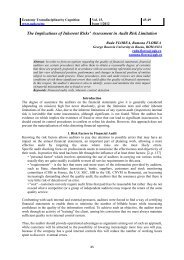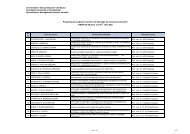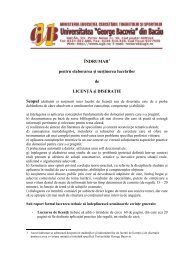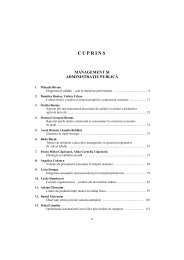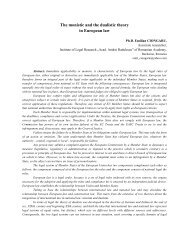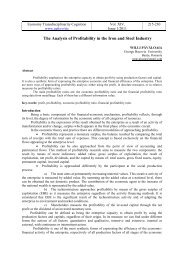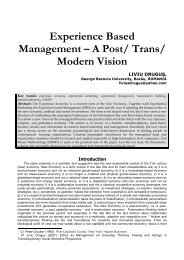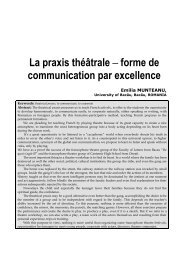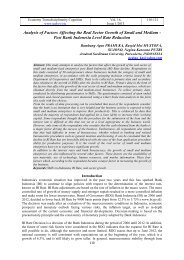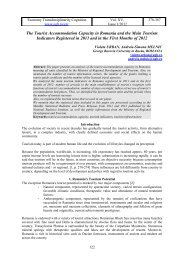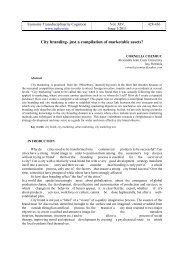BULETIN ÄTIIN IFIC - Universitatea George Bacovia
BULETIN ÄTIIN IFIC - Universitatea George Bacovia
BULETIN ÄTIIN IFIC - Universitatea George Bacovia
Create successful ePaper yourself
Turn your PDF publications into a flip-book with our unique Google optimized e-Paper software.
38<br />
Liviu DRUGU, Toader GHERASIM, Camelia Mihaela CMECIU<br />
Mainly the modern education process was based on induction and deduction, but the<br />
post/transmodern one adds abduction to the previous ones. The triadic thinking is another<br />
postmodern tool of analyzing reality by shaping our minds in order to render the more and<br />
more complex levels of reality. Similarly, the holistic, systemic and poststucturalist thinking<br />
are very useful analytical tools in communication. We are making here a plea for using<br />
these tools in order to prepare future graduates for transformation economy.<br />
EMMY is such a tool not only easy to use, but very useful in a lot of new social<br />
contexts by applying the seven fundamental triads. One of the characteristics of the seven<br />
triads is the very strong accent laid on the third element, such as in the triadic structure of<br />
time (past-present-future), the focus is on future, in the spatial triadic structure (micromacro-mondo)<br />
the focus is on the mondo, and in the existential triadic structure<br />
(substance, energy, information), the accent is put on information and so on. This disequilibrated<br />
accent is put on the third element/part of the triad just because the modern<br />
education process dis-equilibrated the triad by putting the accent on the first or, more<br />
recently, on the second one. So, our dis-equilibrated accent on the third element is meant<br />
to make a real equilibrium among the three parts (1/3 + 1/3 + 1/3 = 1).<br />
To conclude these last third dimensions of the triadic structures are: future, mondo/ global<br />
dimension, information, ethic, ethics/ management, end/means, Father (in the Holy Trinity).<br />
These third elements are quite consonant with Stefan Lupascu’s logic of the included<br />
third. This kind of logic is one of the three constituent parts of transdisciplinarity in Basarab<br />
Nicolesco’s vision. That is why the education process should adapt its methods and<br />
purposes to the new demands of a very complex and dynamic labour market. The<br />
complexity is another constituent part of transdiscplinarity which argues the necessity to<br />
overcome the disciplinarity as a level of reality specific to modern times.<br />
As a concrete step in making a practical reform of the (higher) education, the new<br />
transdisciplinary approach is fundamental. There are already many studies on these<br />
concrete steps 12 . In this context, we propose to education policy representatives, university<br />
representatives and business representatives to consider the necessity of making a<br />
common plea meant to coordinate the efforts of implementing transdisciplinary thinking in<br />
universities, transdevelopment thinking in education policy and transformation economy in<br />
business activity. This is a concrete way of shaping new forms of practical links between<br />
the three above mentioned fields. We do consider that it could be of real help in this<br />
respect if the board of this conference would invite those representatives to analyze and to<br />
decide whether this proposal should be accepted and implemented as soon as possible.<br />
Also, the representative of Knowledge Science Foundation should transmit this proposal to<br />
the headquarters. Several times one of the authors has tried to contact the Joint Research<br />
Center from Ispra, Italy an organization created as a stimulus to grow a European<br />
Research Area, under the auspices of the European Commission, and forwarded a similar<br />
proposal but no answer was given. More than that, we think that the Directorate-General<br />
for Education and Culture should be more involved in this kind of reforms.<br />
Our attempt was/is highly motivated by the above mentioned lack of dialogue<br />
between organizations, especially created for implementing new methods in education and<br />
research. Our proposal is to transform this kind of scientific meetings as the First SPACE<br />
Conference into effective communication tools for shaping the new practical roles of higher<br />
education and research.<br />
<br />
12 Bertea, Mircea, Florescu, Maria, Isac, Ionu, Vasiu, Adrian, Vasiu, Angela: Transdisciplinary Educational<br />
Achievements In Romania http://www.history-cluj.ro/SU/cercet/IsacIonut/Isac%20-%20Transdisciplinary%20<br />
Educational % 20Achievements.htm.<br />
There is, as well, a Transdisciplinary Sustainability Analysis, Modeling and Assessment" Hub (TSAMA), a<br />
web network – promoted by University of Jahannesburg – which actively promotes transdisciplinarity and<br />
sustainable development.



